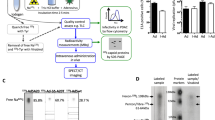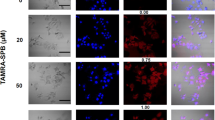Abstract
Our laboratory has investigated replicating adenovirus-human sodium iodide symporter (Ad-hNIS) vectors in a combinatorial oncolytic approach known as radiovirotherapy. However, hNIS-mediated iodide sequestration requires an intact cell membrane, and the enhancement of infectivity may alter the radioiodide accumulation in vivo. To assess these effects, we constructed Ad-NIS vectors expressing NIS from the major late promoter. Viral tropism was altered using a hybrid Ad5/3 fiber, and rates of viral spread altered through expression of the Ad death protein (ADP). The hybrid 5/3 fiber enhanced Ad-mediated cytolysis and radioisotope uptake in vitro. Replicating ADP-lacking viral vectors showed levels of uptake similar to non-replicating vectors that declined as cells lysed. ADP expression enhanced the rate of cell lysis and viral release, but reduced the peak and duration of radioiodide uptake. SPECT-computed tomography imaging showed the Ad5/3-noADP-hNIS vector induced significantly more isotope uptake than other vector structures, indicating that viral spread may not always make up for the reduced NIS expression as in our work with prostate cancer. These results indicate that replicating, infectivity-enhanced Ad-NIS vectors provide superior overall efficacy, but also indicate that the effect of replication speed requires tumor and model-specific testing.
This is a preview of subscription content, access via your institution
Access options
Subscribe to this journal
Receive 12 print issues and online access
$259.00 per year
only $21.58 per issue
Buy this article
- Purchase on Springer Link
- Instant access to full article PDF
Prices may be subject to local taxes which are calculated during checkout





Similar content being viewed by others
References
Deaths by Cause, in WHO Regions, estimates for 2008.. 2011 available from http://apps.who.int/ghodata/?vid=10015.
Hanahan D, Weinberg Robert A . Hallmarks of cancer: the next generation. Cell 2011; 144: 646–674.
Luster M, Clarke S, Dietlein M, Lassmann M, Lind P, Oyen W et al. Guidelines for radioiodine therapy of differentiated thyroid cancer. Eur J Nucl Med Mol Imaging 2008; 35: 1941–1959.
Cho J-Y, Xing S, Liu X, Buckwalter TLF, Hwa L, Sferra TJ et al. Expression and activity of human NA+/I- symporter in human glioma cells by adenovirus mediated gene therapy. Gene Ther. [Article]. 2000; 7: 740–749.
Spitzweg C, Dietz AB, O’Connor MK, Bergert ER, Tindall DJ, Young CY et al. In vivo sodium iodide symporter gene therapy of prostate cancer. Gene Ther 2001; 8: 1524–1531.
Trujillo M, Oneal M, Davydova J, Bergert E, Yamamoto M, Morris J . Construction of an MUC-1 promoter driven, conditionally replicating adenovirus that expresses the sodium iodide symporter for gene therapy of breast cancer. Breast Cancer Res 2009; 11: R53.
Trujillo MA, Oneal MJ, McDonough S, Qin R, Morris JC . A probasin promoter, conditionally replicating adenovirus that expresses the sodium iodide symporter (NIS) for radiovirotherapy of prostate cancer. Gene Ther 2010; 17: 1325–1332.
Li H, Peng KW, Dingli D, Kratzke RA, Russell SJ . Oncolytic measles viruses encoding interferon [beta] and the thyroidal sodium iodide symporter gene for mesothelioma virotherapy. Cancer Gene Ther 2010; 17: 550–558.
Goel A, Carlson SK, Classic KL, Greiner S, Naik S, Power AT et al. Radioiodide imaging and radiovirotherapy of multiple myeloma using VSV(Δ51)-NIS, an attenuated vesicular stomatitis virus encoding the sodium iodide symporter gene. Blood 2007; 110: 2342–2350.
Barton KN, Stricker H, Brown SL, Elshaikh M, Aref I, Lu M et al. Phase I study of noninvasive imaging of adenovirus-mediated gene expression in the human prostate. Mol Ther 2008; 16: 1761–1769.
Galanis E Recombinant measles virus vaccine therapy and oncolytic virus therapy in treating patients with progressive, recurrent, or refractory ovarian epithelial cancer or primary peritoneal cancer. 2011 (ongoing); available from: clinicaltrials.gov/ct2/show/NCT00408590.
Davis BJ Gene therapy and radioactive iodine in treating patients with locally recurrent prostate cancer that did not respond to external-beam radiation terapy. 2011 (ongoing); Available from: http://clinicaltrials.gov/ct2/show/NCT00788307.
Dingli D, Peng K-W, Harvey ME, Greipp PR, O'Connor MK, Cattaneo R et al. Image-guided radiovirotherapy for multiple myeloma using a recombinant measles virus expressing the thyroidal sodium iodide symporter. Blood 2004; 103: 1641–1646.
Waehler R, Russell SJ, Curiel DT . Engineering targeted viral vectors for gene therapy. Nat Rev Genet 2007; 8: 573–587.
Penheiter AR, Griesmann GE, Federspiel MJ, Dingli D, Russell SJ, Carlson SK . Pinhole micro-SPECT/CT for noninvasive monitoring and quantitation of oncolytic virus dispersion and percent infection in solid tumors. Gene Ther 2012; 19: 279–287.
Trujillo MA, Oneal MJ, McDonough S, Morris JC . Viral dose, radioiodine uptake, and delayed efflux in adenovirus mediated NIS radiovirotherapy correlates with treatment efficacy. Gene Ther. epub ahead of print 13 September 2012 doi:10.1038/gt.2012.71.
Dingli D, Cascino MD, Josić K, Russell SJ, Bajzer Ž . Mathematical modeling of cancer radiovirotherapy. Math Biosci 2006; 199: 55–78.
Davydova J, Gavrikova T, Brown EJ, Luo X, Curiel DT, Vickers SM et al. In vivo bioimaging tracks conditionally replicative adenoviral replication and provides an early indication of viral antitumor efficacy. Cancer Sci 2010; 101: 474–481.
Ono HA, Le LP, Davydova JG, Gavrikova T, Yamamoto M . Noninvasive visualization of adenovirus replication with a fluorescent reporter in the E3 region. Cancer Res 2005; 65: 10154–10158.
Tollefson AE, Scaria A, Hermiston TW, Ryerse JS, Wold LJ, Wold WS . The adenovirus death protein (E3-11.6K) is required at very late stages of infection for efficient cell lysis and release of adenovirus from infected cells. J Virol 1996; 70: 2296–2306.
Heideman DAM, Snijders PJF, Craanen ME, Bloemena E, CJLM Meijer, Meuwissen SGM et al. Selective gene delivery toward gastric and esophageal adenocarcinoma cells via EpCAM-targeted adenoviral vectors. Cancer Gene Ther 2001; 8: 342–351.
Matsumoto K, Shariat SF, Ayala GE, Rauen KA, Lerner SP . Loss of coxsackie and adenovirus receptor expression is associated with features of aggressive bladder cancer. Urology 2005; 66: 441–446.
Rauen KA, Sudilovsky D, Le JL, Chew KL, Hann B, Weinberg V et al. Expression of the coxsackie adenovirus receptor in normal prostate and in primary and metastatic prostate carcinoma. Cancer Res 2002; 62: 3812–3818.
Sachs MD, Rauen KA, Ramamurthy M, Dodson JL, De Marzo AM, Putzi MJ et al. Integrin αv and coxsackie adenovirus receptor expression in clinical bladder cancer. Urology 2002; 60: 531–536.
Krasnykh VN, Mikheeva GV, Douglas JT, Curiel DT . Generation of recombinant adenovirus vectors with modified fibers for altering viral tropism. J Virol 1996; 70: 6839–6846.
Wang H, Li Z-Y, Liu Y, Persson J, Beyer I, Moller T et al. Desmoglein 2 is a receptor for adenovirus serotypes 3, 7, 11 and 14. Nat Med 2011; 17: 96–104.
Ono HA, Davydova JG, Adachi Y, Takayama K, Barker SD, Reynolds PN et al. Promoter-controlled infectivity-enhanced conditionally replicative adenoviral vectors for the treatment of gastric cancer. J Gastroenterol 2005; 40: 31–42.
Stevenson SC, Rollence M, Marshall-Neff J, McClelland A . Selective targeting of human cells by a chimeric adenovirus vector containing a modified fiber protein. J Virol 1997; 71: 4782–4790.
Goodrum FD, Ornelles DA . The early region 1B 55-kilodalton oncoprotein of adenovirus relieves growth restrictions imposed on viral replication by the cell cycle. J Virol 1997; 71: 548–561.
Luo J, Deng Z-L, Luo X, Tang N, Song W-X, Chen J et al. A protocol for rapid generation of recombinant adenoviruses using the AdEasy system. Nat Protocols 2007; 2: 1236–1247.
Davydova J, Le LP, Gavrikova T, Wang M, Krasnykh V, Yamamoto M . Infectivity-enhanced cyclooxygenase-2-based conditionally replicative adenoviruses for esophageal adenocarcinoma treatment. Cancer Res 2004; 64: 4319–4327.
Klutz K, Willhauck M, Dohmen C, Wunderlich N, Knoop K, Zach C et al. Image-guided tumor-selective radioiodine therapy of liver cancer after systemic nonviral delivery of the sodium iodide symporter gene. Hum Gene Ther 2011; 22: 1563–1574.
Oneal MJ, Trujillo MA, Davydova J, McDonough SJ, Yamamoto M, Morris JC . Characterization of infectivity-enhanced conditionally replicating adenovectors for prostate cancer radiovirotherapy. Hum Gene Ther 2012; 23: 951–959.
Cheng J, Sauthoff H, Huang Y, Kutler DI, Bajwa S, Rom WN et al. Human matrix metalloproteinase-8 gene delivery increases the oncolytic activity of a replicating adenovirus. Mol Ther 2007; 15: 1982–1990.
Acknowledgements
We thank Tracy Decklever of the Mayo Nuclear Medicine Animal imaging resource for her assistance with SPECT-computed tomography imaging. This work was funded in part by the Minnesota Partnership for Biotechnology and Medical Genomics grant #08-06 (JCM and MY) and NIH grants R01CA094084 and P50CA101955 project 4 (MY).
Author information
Authors and Affiliations
Corresponding author
Ethics declarations
Competing interests
The authors declare no conflict of interest.
Additional information
Supplementary Information accompanies the paper on Cancer Gene Therapy website
Supplementary information
Rights and permissions
About this article
Cite this article
Oneal, M., Trujillo, M., Davydova, J. et al. Effect of increased viral replication and infectivity enhancement on radioiodide uptake and oncolytic activity of adenovirus vectors expressing the sodium iodide symporter. Cancer Gene Ther 20, 195–200 (2013). https://doi.org/10.1038/cgt.2013.4
Received:
Revised:
Accepted:
Published:
Issue Date:
DOI: https://doi.org/10.1038/cgt.2013.4



